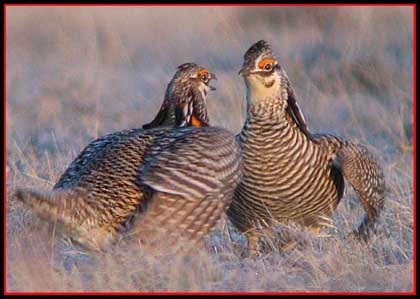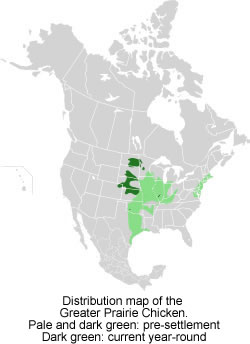 |
Canku Ota
|
 |
|
(Many Paths)
|
||
|
An Online Newsletter
Celebrating Native America
|
||
|
December 1, 2009 - Volume
7 Number 12
|
||
|
|
||
|
Greater Prairie Chicken
|
||
|
From Wikipedia, the
free encyclopedia
|
||
 The
Greater Prairie Chicken, Tympanuchus cupido, is a large bird in
the grouse family. This North American species was once abundant,
but has become extremely rare or extinct over much of its range
due to habitat loss. There are current efforts to help this species
gain the numbers that it once had. One of the most famous aspects
of these creatures is the mating ritual called booming. The
Greater Prairie Chicken, Tympanuchus cupido, is a large bird in
the grouse family. This North American species was once abundant,
but has become extremely rare or extinct over much of its range
due to habitat loss. There are current efforts to help this species
gain the numbers that it once had. One of the most famous aspects
of these creatures is the mating ritual called booming.
Description Subspecies
Threats Human interactions are by far the greatest threat. The conversion of native prairie to cropland is very detrimental to these birds. It was found in a radio telemetry study conducted by Kansas State University that "most Prairie Chicken hens avoided nesting or rearing their broods within a quarter-mile of power lines and within a third-mile of improved roads." (Kansas Department of Wildlife and Parks) It was also found that the Prairie Chickens avoided communication towers and rural farms. Sexual
behavior After mating has taken place, the females will move about one mile from the booming grounds and begin to build their nests. Hens lay between 5 and 17 eggs per clutch and the eggs take between 23 and 24 days to hatch. There are between five and 10 young per brood. (INRIN, 2005). The young are raised by the female and fledge in one to four weeks, are completely independent by the tenth to twelfth week, and reach sexual maturity by age one (Ammann, 1957). One problem facing Prairie Chickens is competition with the Ring-necked Pheasants. Pheasants will lay their eggs in Prairie Chicken nests. The pheasant eggs hatch first; this causes the Prairie Chickens to leave the nest thinking that the young have hatched. In reality the eggs did not hatch and the young usually die because the mother is not there to incubate the eggs. |
|
|
||
|
|
||
| Canku Ota is a free Newsletter celebrating Native America, its traditions and accomplishments . We do not provide subscriber or visitor names to anyone. Some articles presented in Canku Ota may contain copyright material. We have received appropriate permissions for republishing any articles. Material appearing here is distributed without profit or monetary gain to those who have expressed an interest. This is in accordance with Title 17 U.S.C. Section 107. | ||
|
Canku Ota is a copyright ©
2000, 2001, 2002, 2003, 2004, 2005, 2006, 2007, 2008, 2009 of Vicki
Barry and Paul Barry.
|
||
 |
 |
|
|
The "Canku
Ota - A Newsletter Celebrating Native America" web site and
its design is the
|
||
|
Copyright ©
1999, 2000, 2001, 2002, 2003, 2004, 2005,
2006, 2007, 2008, 2009 of Paul
C. Barry.
|
||
|
All Rights Reserved.
|
||
 Population
and habitat
Population
and habitat